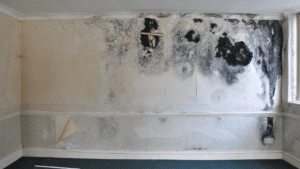
Mould: it’s a word that can make any property owner shudder. Not only does mould pose health risks to occupants, but it can also lead to significant structural damage and devalue a property. Mould spores are omnipresent, and lie dormant until the right conditions—moisture, warmth, stagnant air, and darkness—bring them to life. For commercial property owners, understanding the causes of mould and knowing how to prevent it is essential for maintaining a healthy, attractive, and valuable property.
The Mould Menace: Causes and Conditions
Mould is not a sign of neglect; it’s a biological reality waiting for the right conditions. High relative humidity levels over 70%, lack of air movement, temperatures above 21 degrees, and darkness are the main culprits that encourage mould growth. Each of these factors can be managed with proper building maintenance and design.
Key Types of Mould in Commercial Settings
Several mould types can infest commercial properties, each with unique characteristics and implications:
- Stachybotrys: Also known as black mould, Stachybotrys is notorious for its toxicity. It prefers damp, cellulose-rich environments and can cause severe allergic reactions. Recognizable by its dark greenish or black colour and slimy texture, it’s a mould type that demands immediate attention.
- Penicillium: Easily identifiable by its blue or green coloured surface with a velvety texture, Penicillium can spread quickly, often in water-damaged buildings. It presents health risks, particularly for those with allergies or compromised immune systems.
- Cladosporium: This mould thrives in both warm and cold conditions and can be found in various indoor materials such as fabrics and carpets. It’s typically dark-looking and is one of the most common indoor and outdoor moulds.
Mitigation and Remediation Strategies
For property owners, the first step in mould management is prevention:
- Humidity Control: Maintain indoor humidity levels below 70%. Use dehumidifiers where necessary, particularly in basements or other areas prone to dampness.
- Ventilation: Ensure that buildings are well-ventilated. Use exhaust fans in bathrooms and kitchens to remove excess moisture. Consider air exchange systems that replace stale indoor air with fresh outdoor air.
- Temperature Regulation: Keep indoor temperatures regulated. Avoid sudden temperature fluctuations that can cause condensation, particularly on windows and walls.
- Lighting: Mould dislikes ultraviolet light, so use natural light where possible. In darker areas, consider UV lights to inhibit mould growth.
- Regular Inspections: Conduct regular mould inspections, especially after rain or known water exposure. Early detection is key to preventing widespread mould infestation.
- Professional Cleanup: If mould is found, it’s often best to hire a professional remediation service. They have the equipment and expertise to safely remove mould and prevent its return.
Impact on Health and Business
The health implications of mould are well-documented: from allergic reactions to more serious respiratory conditions. For businesses, the presence of mould can mean lost productivity, liability issues, and a tarnished reputation.
Educate Tenants and Staff
Educating tenants and staff about the signs of mould and how to prevent it is critical. Everyone should be aware of the importance of reporting water leaks or spills immediately, as these can quickly lead to mould issues.
Insurance Considerations
Make sure that your property insurance covers mould damage and remediation. Some policies have specific exclusions or limitations related to mould, so it’s important to understand what is and isn’t covered.
Leveraging Technology
Today’s smart buildings offer new opportunities for mould prevention. Sensors can monitor humidity and temperature, alerting property managers to conditions that might lead to mould growth.
The Takeaway
Mould can be a serious problem in commercial properties, but with proactive management, it’s a problem that can be contained. By understanding the causes of mould and implementing effective prevention strategies, commercial property owners can protect both their investments and the health of their tenants.
This article aims to inform and engage LinkedIn’s professional audience by providing actionable insights on mould prevention and remediation—a topic highly relevant to property management and real estate sectors. It’s tailored to the informational needs and interests of LinkedIn users, focusing on best practices, health implications, and business impacts of mould in commercial settings.
